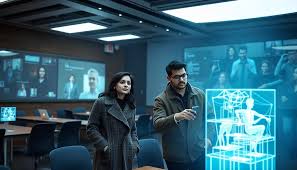The education system is undergoing a profound transformation as we enter the 21st century. With rapid advancements in technology, shifts in societal needs, and the evolving job market, traditional educational methods are being rethought and reimagined. Innovative approaches to education are not just enhancing learning experiences but also ensuring that students are better prepared for the future. In this article, we explore some of the most exciting trends and ideas shaping the future of education.
1. Personalized Learning: Tailoring Education to Individual Needs
One of the most significant innovations in modern education is the move toward personalized learning. Instead of a one-size-fits-all approach, personalized learning allows students to learn at their own pace and according to their unique needs, strengths, and interests.
- Adaptive Learning Technology: Tools powered by AI and machine learning are helping to create customized learning experiences. Platforms like Khan Academy and Duolingo adjust the difficulty level based on individual progress, allowing for a more tailored learning journey.
- Competency-Based Learning: This approach focuses on mastery of skills rather than the number of hours spent in the classroom. Students move forward only when they’ve demonstrated a full understanding of the material, ensuring a deeper grasp of content.
2. Project-Based Learning (PBL): Learning Through Real-World Problems
Project-based learning (PBL) is an innovative teaching method that encourages students to work on projects related to real-world problems. This approach shifts the focus from traditional lectures to hands-on, collaborative work that develops critical thinking, problem-solving, and teamwork skills.
- Real-World Relevance: Students working on real projects can see the tangible impact of their learning, increasing motivation and engagement.
- Cross-Disciplinary Learning: PBL often involves a blend of subjects, which mirrors the way problems are solved in the real world, encouraging interdisciplinary knowledge.
3. Blended Learning: Combining the Best of Online and In-Person Education
Blended learning combines the flexibility of online learning with the structure of traditional classroom instruction. This hybrid approach is rapidly becoming a staple in both K-12 education and higher learning institutions.
- Flipped Classrooms: In a flipped classroom, students learn new content at home through videos and online resources and then engage in interactive activities and discussions during class time, promoting active learning.
- Accessibility and Flexibility: Blended learning offers greater flexibility, enabling students to access lessons from anywhere and at any time, making education more accessible and accommodating various learning styles.
4. Artificial Intelligence in Education: Revolutionizing Teaching and Learning
Artificial intelligence (AI) is reshaping the landscape of education, making learning more efficient, personalized, and accessible. AI-powered tools can automate administrative tasks, analyze student performance, and provide customized learning experiences.
- AI Tutors: Virtual assistants, such as AI-powered tutors, can provide instant feedback to students, answering questions and guiding them through challenging content outside of regular class hours.
- Automated Grading: AI systems can quickly grade assignments and tests, allowing teachers to spend more time focusing on student engagement and interaction rather than administrative tasks.
5. Gamification: Making Learning Fun and Engaging
Gamification is the integration of game mechanics and principles into the learning process. By incorporating elements like challenges, rewards, and competitive elements, educators can increase engagement and motivation.
- Interactive Learning: Platforms such as Kahoot! and Quizlet use gamified quizzes and learning games to make reviewing material fun and interactive.
- Intrinsic Motivation: Gamification taps into students’ natural desire to win, level up, and achieve, fostering a deeper connection to the learning material.
6. Global Learning Communities: Connecting Students Worldwide
As technology continues to break down geographic barriers, students can now collaborate with peers from around the world. Global learning communities foster cultural awareness, global citizenship, and the exchange of diverse ideas and perspectives.
- Virtual Exchange Programs: Programs like ePals and Skype in the Classroom allow students to communicate with peers in different countries, collaborate on projects, and learn about global issues.
- Language Learning: Technology has also made it easier for students to learn new languages through immersive experiences, connecting them with native speakers and enabling cultural exchange.
7. Focus on Emotional and Social Learning (SEL)
In the 21st century, emotional and social learning (SEL) is becoming an integral part of the educational experience. SEL focuses on helping students manage emotions, build positive relationships, and make responsible decisions—skills that are essential for both personal and professional success.
- Mindfulness and Wellbeing: Schools are increasingly adopting mindfulness practices and wellness programs that teach students how to manage stress, stay emotionally resilient, and improve focus.
- Developing Empathy: By incorporating SEL into curricula, educators help students understand and appreciate diverse perspectives, fostering inclusivity and empathy.
8. STEAM Education: Bridging the Gap Between Arts and Sciences
While STEM (Science, Technology, Engineering, and Mathematics) has traditionally been a focus, STEAM (Science, Technology, Engineering, Arts, and Mathematics) is gaining popularity. This approach integrates the arts into STEM fields, encouraging creativity, innovation, and critical thinking.
- Creative Problem-Solving: Combining arts and sciences allows students to approach problems from multiple angles, fostering creativity and out-of-the-box thinking.
- Interdisciplinary Learning: STEAM initiatives encourage students to see the connections between disciplines, enhancing their ability to think and work across subjects.
9. Virtual and Augmented Reality: Immersive Learning Experiences
Virtual Reality (VR) and Augmented Reality (AR) technologies are becoming game-changers in the classroom, providing immersive learning experiences that go beyond traditional textbooks.
- Interactive Simulations: VR allows students to explore historical sites, conduct virtual science experiments, or even interact with simulations of distant planets, enhancing their understanding of complex concepts.
- Immersive Learning: AR overlays digital information onto the real world, making learning experiences more engaging and interactive. For example, AR can be used to enhance anatomy lessons by allowing students to interact with 3D models of the human body.
10. Lifelong Learning: Education Beyond the Classroom
In the 21st century, education is no longer confined to childhood or young adulthood. Lifelong learning is a critical component of personal and professional growth, as individuals must continually update their skills to stay competitive in an ever-changing world.
- Online Learning Platforms: With the rise of platforms like Coursera, edX, and Udemy, individuals can pursue higher education, professional development, and new skills at any stage of their lives.
- Microlearning: Short, focused learning sessions, often delivered through mobile apps, allow individuals to learn new skills in small, manageable doses, fitting into their busy schedules.
Conclusion: The Future of Education is Bright
The 21st century is ushering in a new era of education—one that is more personalized, engaging, and connected than ever before. By embracing innovative educational approaches such as personalized learning, AI-powered tools, project-based learning, and more, we are shaping a future where education is accessible, inclusive, and impactful for all. As we continue to reimagine education, we ensure that students are better prepared to navigate the challenges and opportunities that await them in an increasingly complex world.
SEO Considerations:
- Primary Keyword: Innovative Approaches to Education
- Secondary Keywords: Future of Education, Education Trends, 21st Century Education, Personalized Learning, Project-Based Learning, Blended Learning, AI in Education, Gamification in Education, Lifelong Learning, STEAM Education
- Meta Description: Explore the innovative approaches reshaping education in the 21st century, from personalized learning and AI to gamification and global learning communities.
- URL Slug: reimagining-education-innovative-approaches-for-the-21st-century

